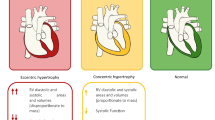Abstract
Pulmonary arterial hypertension in children can occur secondary to shunt lesion like ventricular septal defect, patent ductus arteriosus or it may be idiopathic, the so-called primary pulmonary hypertension (PPH). The progression of PPH is usually rapid in children as compared to adults and the mean survival is 2–3 years after the diagnosis is made. Histological changes in the form of medical muscular hypertrophy, intinal hyperplasia and later angiornatous, plexiform lesions occur in pulmonary vasculature. The pulmonary vasculature normally is a high flow, low resistance circuit and allows large blood flow without marked increase in pulmonary arterial pressure. However, with prolonged increased flow or any other vasoconstrictor stimulus, histological changes start occuring in the pulmonary bed resulting in increasing pressure in pulmonary artery. Right ventricular hypertension follows resulting in right ventricular hypertrophy and later dysfunction. Life threatening arrhythmias may result in sudden death in some of these patients. Clinical presentation is in the form of exertional dyspnoea with syncope at times. Over 50% of children with PPH are helped by vasodilators. They may be treated with calcium channel blockers (e.g. nifedipine, dose titrated to blood pressure) orally. Those not responding to oral vasodilators can be put on chronic inhaled nitric oxide or continuous intravenous prostacyclin infusion. Chronic anticoagulation therapy may also increase survival. In symptomatic cases, blade/balloon atrial septostomy may increase survival in patients of PPH with intact atrial sptum. For children not responding to medical therapy, lung transplantation may be the answer in near future.
Similar content being viewed by others
References
Rich S, Dantzker DR, Ayres SM. Primary pulmonary hypertension: A national prospective study.Ann Intern Med 1991; 115: 343–349
Thilenius OG, Nadas AS, Jockin H. Primary pulmonary vascular obstruction in children.Pediatrics 1965; 36: 75–87.
D’Alonzo Ge, Barst FJ, Ayres SMet al. Survival in patients with primary pulmonary hypertension: results from a national prospective registry.Ann Inten Med 1991; 115: 343–349.
Heath D, Smith P, Gonsey Jet al. The pathology of early and late stages of primary pulmonary hypertension.Br Heart J 1987; 58: 204–213.
Wagenvoort C, Wagenvoort N. Primary pulmonary hypertension. A pathological study of the lung vessels in 156 clinically diagnosed cases.Circulation 1970; 42: 1163–1184.
Rich S, Kaufmann E, Levy PS. The effect of high doses of calcium channel blockers on survival in primary pulmonary hypertension.N Engl J Med 1992; 327: 76–81.
Packer M, Medina N, Yushak M. Adverse hemodynamic and clinical effects of calcium channel blockage in pulmonary hypertension secondary to obliterative pulmonary vascular disease.J Am Coll Cardiol 1984; 4: 890.
Rich S, Martinez J, Lam W, Levy PS, Rosen KM. Reassessment of the effects of vosodilator drug in primary pulmonary hypertension.Am Heart J 1984; 105: 119–127.
Sendoval J, Bauorle O, Gomez Aet al. Primary pulmonary hypertension in children: Clinical characterization and survival.J Am Coll Cardiol 1995; 23(2): 466–474.
Rubin LJ. Primary pulmonary hypertension: an ACCP consensus statement.Chest 1993; 104: 236–250.
Barst RJ. Pharmacologically induced pulmonary vasodilatation in children and young adults with primary pulmonary hypertension.Chest 1986; 98: 497–503.
Barst RJ, Long W, Gersony WM. Long-term vasodilator treatment improves survival in children with primary pulmonary hypertension.Cardiol Young 1993; 3(SI): 89.
Rubin LJ, Groves BM, Reeves JT, Frosolono, Cato AE. Prostacyclin-induced pulmonary vasodilatation in primary pulmonary hypertension.Circulation 1982; 66: 334–338.
Barst RJ, Rubin LJ, McGoon MD, Caldwell EJ, Long WA, Levy PS. Survival in primary pulmonary hypertension with long term continuous intravenous prostacyclin.Ann Int Med 1994; 121: 409–415.
Kerstein D, Levy PS, Hsu DTet al. Blade balloon atrial septostomy in patients with severe primary pulmonary hypertension.Circulation 1995; 91: 2028–2035.
Author information
Authors and Affiliations
Rights and permissions
About this article
Cite this article
Krishnan, U. Diagnosis and management of primary pulmonary hypertension. Indian J Pediatr 67, 523–527 (2000). https://doi.org/10.1007/BF02760484
Issue Date:
DOI: https://doi.org/10.1007/BF02760484




